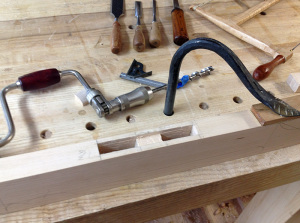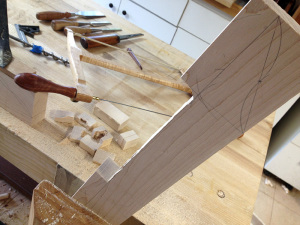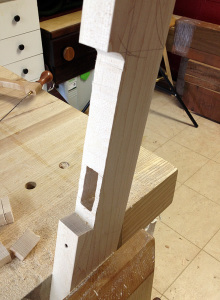Through Mortises in Really Hard Wood
I’m gearing up for Hand Tool School Semester 5 right now. I built a spring pole lathe about 5 months ago as part of this, but I’m finding myself building another one because I’m just not happy with the video footage I captured during the build. I started trying to film just isolated parts but by the time I have milled the stock to size to film the joinery elements I figured I would just go ahead and build another one. I will most likely donate it to the Steppingstone Museum when I’m done. Since this was a last minute, unplanned build I grabbed whatever spare stock I had laying about that was logical. In other words, I’m not using my figured Sapele or Birdseye Maple for this lathe. Instead I had several planks of 8/4 Hard Maple that have been in my shop left over from my power tool days. Do any kind of hand tool work with Hard Maple and you will quickly realize where the “Rock Maple” nickname came from. Needless to say I confounded any attempt to build this quickly by using a wood that takes 3 times as long to chop a mortise or saw out a curve. No one ever said I make good decisions.
 When working with a really hard wood, you look for shortcuts where you can find them. The 4 mortises in the feet are a good example. These are through mortises 1″ wide and 7″ long with a haunched spot in between to receive twin tenons. However, the bottom of the foot is cut away to change it from 1 long “skid” foot to 2 different pad feet which allows the lathe to stand strong on uneven floors. In my thinking why make the extra effort to chop all the way through the 4″ foot when I can chop half way through and saw away the cut out thus exposing a through mortise.
When working with a really hard wood, you look for shortcuts where you can find them. The 4 mortises in the feet are a good example. These are through mortises 1″ wide and 7″ long with a haunched spot in between to receive twin tenons. However, the bottom of the foot is cut away to change it from 1 long “skid” foot to 2 different pad feet which allows the lathe to stand strong on uneven floors. In my thinking why make the extra effort to chop all the way through the 4″ foot when I can chop half way through and saw away the cut out thus exposing a through mortise.
 So after chopping a hair past the halfway point, I clamped the foot in the vise, tensioned up the bowsaw, and began sawing. A few minutes later and I had a nice cut out with radiused inside corners. Plus any chance to break out my bowsaw I jump on. This thing cuts so nicely and leaves a surface that can be finish ready with just a few swipes of a spokeshave.
So after chopping a hair past the halfway point, I clamped the foot in the vise, tensioned up the bowsaw, and began sawing. A few minutes later and I had a nice cut out with radiused inside corners. Plus any chance to break out my bowsaw I jump on. This thing cuts so nicely and leaves a surface that can be finish ready with just a few swipes of a spokeshave.
 Sawing away the bottom of the mortise saved me a lot of chisel wear and pounding. I also end up with nice clean edges to the mortise since there was plenty of wood to back up my chopping. It makes me wonder if this could be an alternate method to making through mortises. Just leave your board a bit thicker/wider then trim away the excess exposing your joinery. I probably wouldn’t use it in a highly visible area because you can’t quite tell what the face will look like until you saw it away. Certainly you want to make sure your mortise walls are square and true but you should be doing that anyway whether a blind or through mortise. In this case, the mortise is on the bottom of the feet so it really didn’t matter what it looked like just as long as it created a snug fit.
Sawing away the bottom of the mortise saved me a lot of chisel wear and pounding. I also end up with nice clean edges to the mortise since there was plenty of wood to back up my chopping. It makes me wonder if this could be an alternate method to making through mortises. Just leave your board a bit thicker/wider then trim away the excess exposing your joinery. I probably wouldn’t use it in a highly visible area because you can’t quite tell what the face will look like until you saw it away. Certainly you want to make sure your mortise walls are square and true but you should be doing that anyway whether a blind or through mortise. In this case, the mortise is on the bottom of the feet so it really didn’t matter what it looked like just as long as it created a snug fit.
Where and when I use this technique still requires some thought, but it is just another thing to tuck away for the future. Choosing the best tool for the job takes on a new meaning when working in really hard wood. Sometimes the tool changes or sometimes you change the process slightly as in this case. I chop mortises pretty quickly to the point where I have forsaken the auger method for anything narrower than about 1/2″. In this case it would have taken a long time using a 1″ bench chisel involving nibbling away little by little and making frequent trips to the sharpening bench. Instead with a 1″ auger and brace, some light chisel paring, a bowsaw, and half the time and abuse to me and my tools, I arrived at the same destination.
I think this is why it is necessary to keep an open mind and try many different techniques in woodworking. You never know when your tried and true method will fail and another technique or combination of techniques will need to be employed. Besides learning new things is fun!
Stay tuned and I’ll show you another way to cut through mortises really quickly that will work for really visible surfaces.


